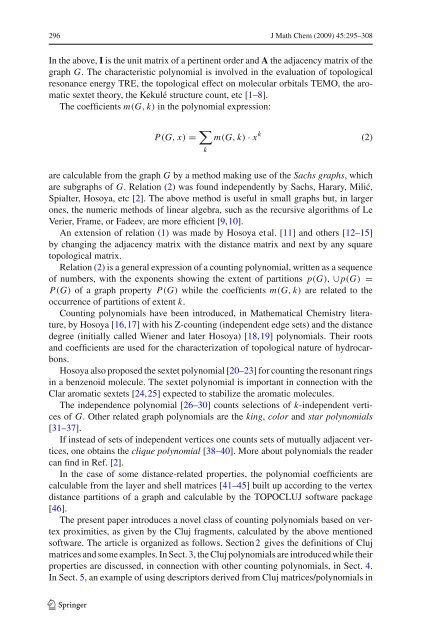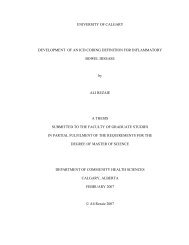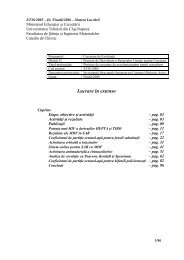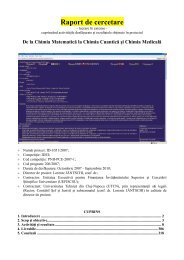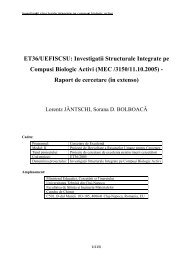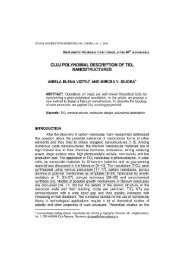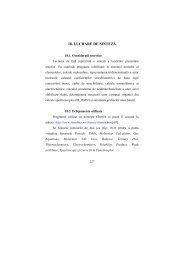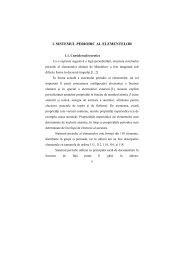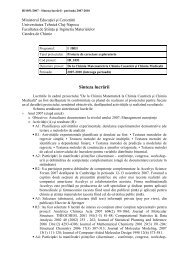Cluj polynomials
Cluj polynomials
Cluj polynomials
Create successful ePaper yourself
Turn your PDF publications into a flip-book with our unique Google optimized e-Paper software.
296 J Math Chem (2009) 45:295–308<br />
In the above, I is the unit matrix of a pertinent order and A the adjacency matrix of the<br />
graph G. The characteristic polynomial is involved in the evaluation of topological<br />
resonance energy TRE, the topological effect on molecular orbitals TEMO, the aromatic<br />
sextet theory, the Kekulé structure count, etc [1–8].<br />
The coefficients m(G, k) in the polynomial expression:<br />
P(G, x) = <br />
m(G, k) · x k<br />
k<br />
are calculable from the graph G by a method making use of the Sachs graphs, which<br />
are subgraphs of G. Relation (2) was found independently by Sachs, Harary, Milić,<br />
Spialter, Hosoya, etc [2]. The above method is useful in small graphs but, in larger<br />
ones, the numeric methods of linear algebra, such as the recursive algorithms of Le<br />
Verier, Frame, or Fadeev, are more efficient [9,10].<br />
An extension of relation (1) was made by Hosoya et al. [11] and others [12–15]<br />
by changing the adjacency matrix with the distance matrix and next by any square<br />
topological matrix.<br />
Relation (2) is a general expression of a counting polynomial, written as a sequence<br />
of numbers, with the exponents showing the extent of partitions p(G), ∪p(G) =<br />
P(G) of a graph property P(G) while the coefficients m(G, k) are related to the<br />
occurrence of partitions of extent k.<br />
Counting <strong>polynomials</strong> have been introduced, in Mathematical Chemistry literature,byHosoya[16,17]<br />
with his Z-counting (independent edge sets) and the distance<br />
degree (initially called Wiener and later Hosoya) [18,19] <strong>polynomials</strong>. Their roots<br />
and coefficients are used for the characterization of topological nature of hydrocarbons.<br />
Hosoya also proposed the sextet polynomial [20–23] for counting the resonant rings<br />
in a benzenoid molecule. The sextet polynomial is important in connection with the<br />
Clar aromatic sextets [24,25] expected to stabilize the aromatic molecules.<br />
The independence polynomial [26–30] counts selections of k-independent vertices<br />
of G. Other related graph <strong>polynomials</strong> are the king, color and star <strong>polynomials</strong><br />
[31–37].<br />
If instead of sets of independent vertices one counts sets of mutually adjacent vertices,<br />
one obtains the clique polynomial [38–40]. More about <strong>polynomials</strong> the reader<br />
can find in Ref. [2].<br />
In the case of some distance-related properties, the polynomial coefficients are<br />
calculable from the layer and shell matrices [41–45] built up according to the vertex<br />
distance partitions of a graph and calculable by the TOPOCLUJ software package<br />
[46].<br />
The present paper introduces a novel class of counting <strong>polynomials</strong> based on vertex<br />
proximities, as given by the <strong>Cluj</strong> fragments, calculated by the above mentioned<br />
software. The article is organized as follows. Section 2 gives the definitions of <strong>Cluj</strong><br />
matrices and some examples. In Sect. 3, the <strong>Cluj</strong> <strong>polynomials</strong> are introduced while their<br />
properties are discussed, in connection with other counting <strong>polynomials</strong>, in Sect. 4.<br />
In Sect. 5, an example of using descriptors derived from <strong>Cluj</strong> matrices/<strong>polynomials</strong> in<br />
123<br />
(2)


